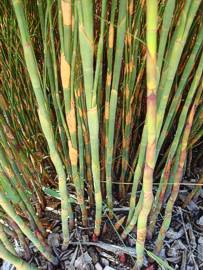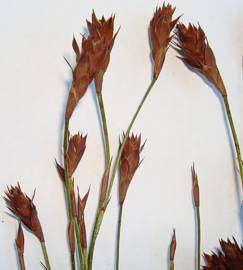Platycaulos callistachyus
Platycaulos callistachyus (Kunth) H.P.Linder
Family: Restionaceae
Common names: none
Introduction
Platycaulos callistachyus is a little known restio. Its interesting culms and dense growth make it a worthy landscaping plant suited to any medium or large-sized garden.

Description
Description
Platycaulos callistachyus is a restio with an upright growth habit. It is a perennial with a relatively long life span and will need replacing after ± 6-9 years. Plants grow in clumps and have densely packed culms (stems) giving a full appearance. This restio grows between 1.0 - 2.5 m tall and has a base and crown diameter of between 0.5 - 2.0 m. The large diameter is due to the spreading underground rhizome.

The rounded culms are evenly spaced along the rhizome giving a neat appearance. When the culms appear as new shoots they are tinged an attractive red. Fertile culms, the ones producing flowers, are branched. Sheaths (reduced leaves) are green when young, turning an attractive yellow to brown with age. They remain wrapped around the culm and do not fall off.
All restios are dioecious which means that males and females occur on separate plants. Male plants have between 2-10 spikelets per inflorescence and female plants have 1 spikelet per inflorescence. The male spikelets are small in comparison to the female spikelets and are 3-5 mm long. The larger female spikelets are 6-15 mm long. Both female and male spikelets are golden brown.


It flowers in March and April and seed is released just before the new flowering season begins. Seeds vary in colour from brown to light grey and are rounded and very small, ± 1.3 mm in diameter.
In general, restios are fast growers and flower at 3 years old.
Conservation Status
Status
Platycaulos callistachyus is listed as Least Concern on the current Red Data List (Raimondo et al. in prep.). It is a widespread, abundant species and is not under any direct or current threats.
Distribution and habitat
Distribution description
Platycaulos callistachyus occurs from Ceres to Uitenhage. It is found in all of the phytogeographic centres in the Cape Region namely the northwest, southwest, Karoo Mountain, Langeberg, Agulhas Plain and the southeast.
This is a fynbos species and grows in soils derived from Table Mountain Sandstone. It occurs at altitudes of between 30-1800 m, although it is more commonly found at the lower altitudes. Water availability is important for this restio. It grows alongside streams or in valleys where there is lots of groundwater available. Rockiness of habitat seems to be variable as it grows in deep sandy soils alongside streams as well as in rocky streambeds. Fynbos species are adapted for rainfall in winter and P. callistachyus experiences rainfall varying between 260-1045 mm per year.
Derivation of name and historical aspects
History
Kunth discovered this restio and found the flower spikes to be most beautiful. He named the species calli (Greek), meaning beautiful, and stachyus (Greek), meaning spike. The genus name also originates from the Greek word, platy, meaning broad, and caulis meaning stems, referring to the large round culms typical of this species.
Platycaulos has eight species, all occurring within the Western Cape, P. callistachyus is the largest. There are ± 480 species of Restionaceae worldwide with 330 species occurring in Africa.
The family name, Restionaceae, refers to the Latin restis, which means cord or rope.
Ecology
Ecology
Restios are pollinated by the wind. The male plants produce copious amounts of pollen that are blown onto female plants, pollinating the flowers. The seeds are small and light and dispersed by the wind.
Platycaulos callistachyus has a well-developed rhizome. This is thought to be an adaptation to its streamside habitat, enabling the plant to anchor in place when streams flood, preventing it from getting washed away. This restio is a resprouter and will send up new shoots from its rhizome after a fire.
Uses
Use
The genus Platycaulos is not very well known and is not used commercially. It is a promising horticultural subject due to its neat and upright habit.
Growing Platycaulos callistachyus
Grow
Platycaulos callistachyus provides a fantastic dense, evergreen backdrop to a water feature or pond. It also makes a very good filler or screening plant in an informal garden where some height is needed.
One can make a feature of this restio by planting low-growing plants around the clumps; allowing a view of the culms and habit of the plant, or mix it amongst fynbos plants of varying heights to create a more natural looking landscape.
Plant it in a well-drained spot in the garden. It is a medium-sized restio and does require a fair amount of space to grow in. Plant in full sun or light shade, although in the shade the plants will tend to elongate and have softer growth. No pruning is needed other than to occasionally remove dead stems. Ensure there is a good layer of mulch present. This keeps the soil cool and reduces evaporation during hot weather. Feed plants regularly with an organic fertilizer until they are established, at least for the first year after planting.
Restios are relatively disease-free plants with no major pests and diseases affecting Platycaulos callistachyus.
There are two ways to propagate restios: dividing the rhizome and sowing seed.
Dividing the rhizome entails digging up an established plant and breaking the rhizome into pieces at least 15 cm long. Plant these pieces into the ground or into pots. Water them well after planting. This is done during winter time before the plant sends up new culms. The plants will take at least a year to start growing strongly and produce new shoots.
At Kirstenbosch we use seed propagation for all the restios. This is a fast and easy method to use if you require large quantities of plants. The seed is planted in April-May (autumn) when the days are warm (20-30°C) and the nights are cool (10-15°C). Treat the seed prior to planting with Instant Smoke Primer. This smoke treatment greatly improves germination. Seed is planted into seed trays 10 cm deep and filled with a well-drained medium. Plant the seed thickly as 50 % of restio seed is not viable. Cover the seed lightly with sand and water. Place the trays in a light well-ventilated area. Keep the trays moist but not wet. After 3-4 weeks germination should take place. Once the plants have developed a few small culms, after ± 6 - 12 weeks, and are 30 mm tall, they can be pricked out into 6-packs or plug trays. Use a fynbos potting medium consisting of 1 part loam, 8 parts bark and 3 parts sand.
Harden off the plants in a semi-shaded area until they are growing strongly (± 4 weeks) before placing in the sun. Once the roots start to show through the bottom of the trays they can be potted into small black bags. After growing on they will be ready to be planted in the garden.
The best time of the year to plant into the garden is autumn or at the beginning of the rainy season. This allows the plant to settle in and grow deep roots before the hot summer season begins. Restios, once established (after the first year), require very little water but this species will thrive if watered regularly.
References
- Brown, N., Jamieson, H. & Botha, P. 1998. Grow restios. Kirstenbosch Gardening Series. National Botanical Institute, Cape Town.
- Goldblatt, P. & Manning, J.C. 2000. Cape Plants. A conspectus of the Cape flora of South Africa. Strelitzia 9. National Botanical Institute, Cape Town.
- Haaksma, E.D. & Linder, H.P. 2000. Restios of the fynbos. Botanical Society of South Africa, Cape Town.
- Linder, H.P. 2006. African Restionaceae 4. CD. Bolus Herbarium, Department of Botany, University of Cape Town, Rondebosch.
- Raimondo, D., Von Staden, L., Foden, W., Victor, J.E., Helme, N.A., Turner, R.C., Kamundi, D.A. & Manyama, P.A. (eds). In prep. Red List of South African plants. Strelitzia.
- Stearn, W.T. 1992. Botanical Latin. Timber Press, Portland, Oregon.
Credits
Louise Nurrish
Kirstenbosch National Botanical Garden
June 2009
Plant Attributes:
Plant Type: Restio
SA Distribution: Eastern Cape, Western Cape
Soil type: Sandy, Loam
Flowering season: Autumn
PH: Acid, Neutral
Flower colour: Brown
Aspect: Full Sun
Gardening skill: Average
Special Features:
Horticultural zones









Rate this article
Article well written and informative
Rate this plant
Is this an interesting plant?
Login to add your Comment
Back to topNot registered yet? Click here to register.